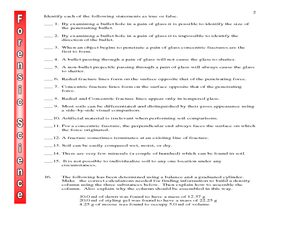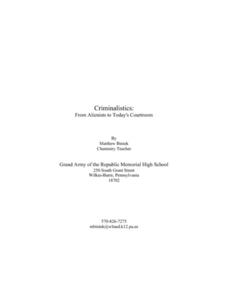Curated OER
DNA Technology
In this DNA technology worksheet, students look at genetic engineering and how it has helped humans. Then students will read about the human genome and how DNA fingerprinting is used in crime scenes. This worksheet has 4 short answer...
Curated OER
Hair Test
In this forensic science activity, students write an open response to 3 short answer questions on hair evidence collected at the crime scene.
Curated OER
Hair Test
In this forensic science learning exercise, students write an open response to 1 question about hair evidence collected from the crime scene.
101 Questions
Bone Collector
Feel like a detective yet? Pupils first watch a brief clip from the movie The Bone Collector. Using a photo of the suspect's footprint next to a dollar bill, they then use proportions to determine the size of the suspect's shoe.
Curated OER
Glass and Soil
In this forensic science lesson, students sketch bullet line fractures and complete 16 short answer questions on glass and soil evidence.
Curated OER
My Science Box: DNA Fingerprinting
Students identify DNA in a crime scenario. In this DNA lesson, students perform paper chromatography and compare it against the pens of various suspects.
Curated OER
Hair Test
In this forensic science worksheet, students write an open response to 3 questions posed about hair evidence in the crime scene. They explain where and why the samples are most likely found.
EngageNY
Newton’s Law of Cooling, Revisited
Does Newton's Law of Cooling have anything to do with apples? Scholars apply Newton's Law of Cooling to solve problems in the 29th installment of a 35-part module. Now that they have knowledge of logarithms, they can determine the decay...
Curated OER
Using Blood Tests to Identify Babies and Criminals
Students solve a crime by matching a suspect's blood type to physical evidence collected at the crime scene. For this forensic science lesson, students identify the different blood types. They explain how blood tests work.
Curated OER
Hair Test
For this forensic science worksheet, students write an open response to 2 questions about a picture of hair evidence collected from the crime scene.
Curated OER
Hair Test
In this forensic science worksheet, students write an open response to 1 question on hair evidence photo taken from the crime scene.
Curated OER
Hair Test
In this forensic science worksheet, students write an answer to 1 open response question about a given hair evidence collected from the crime scene.
Curated OER
Is It A Crime To Be Gay?
Students stage a parliamentary committee hearing in the newly independent Eastern European country of Boldovistan. Role playing characters with differing attitudes towards homosexuality, students testify on legislation to abolish laws...
North Carolina State University
Exploring Genetics Across the Middle School Science and Math Curricula
Where is a geneticist's favorite place to swim? A gene pool. Young geneticists complete hands-on activities, experiments, and real-world problem solving throughout the unit. With extra focus on dominant and recessive genes, Punnett...
Curated OER
"Who Done It?" Analysis of Molecular Fingerprints Left At the Scene of the Crime
Learners examine different types of DNA fragments. They record and analyze their results. They determine who is the criminal in the story.
Curated OER
Science: Criminalistics - A New Look at Crime
Students examine the world of forensic science, focusing on fingerprint analysis. In the lesson, they implement a method by which fingerprints of class members are categorized and identified. Elementary students study classification...
Curated OER
DNA Fingerprinting with Restriction Enzymes
Students will illustrate how restriction enzymes work by piecing together parts of a puzzle. Then they apply this knowledge to help them analyze genetic evidence from the scene of a crime as well as to help them comprehend how a DNA...
Curated OER
Who says I can't be Sherlock Holmes?
Pupils create a "crime scene" in their classroom and have to tell what's out of place. The class is given a set of cards that are all face down and have to play concentration. If they get a matched pair, they get both cards. Whoever has...
Curated OER
DNA Fingerprinting
Students discuss DNA Fingerprinting and gel electrophoresis before participating in a crime solving activity. Students simulate their DNA using adding tape and complete the steps necessary to do a gel electrophoresis. They discuss the...
Curated OER
Interdisciplinary Applications of Chemistry Through Engineering in Modern Medicine
Students explore the different techniques used in forensic science. In this chemistry lesson plan, students investigate a fictional crime and identify the culprit. They create a brochure or collage career bulletin.
Curated OER
Cardiac Arrest! Using Forensics to Investigate Cardiovascular Anatomy and Function
Students identify the different parts and functions of the cardiovascular system. In this forensics lesson, students collect and analyze evidence on a fictional crime. They describe different causes of cardiac arrest.
Curated OER
CSI Lesson Plans Can Turn Students Into Learning Detectives
Children learn to use the methods of good detection for solving a crime, and even analyzing literature.
Curated OER
Infrared Spectroscopy in Forensic Chip Analysis
Young scholars analyze spectrums as related to forensics. In this chemistry lesson plan, students define spectroscopy and discuss its use in chemistry. They discuss how the Forensic Paint Chip is used to help solve crimes.
Curated OER
Blood Analysis
Students reconstruct a crime scene to produce the blood spatter pattern. In this forensic science instructional activity, students describe the events that lead to produce such patterns. They explain the importance of blood analysis in...
Other popular searches
- Crime Scene Investigator
- Crime Scene Scenarios
- Crime Scene Forensics
- Crime Scene Investigations
- Simulated Crime Scene
- Crime Scene Chromatography
- Recording the Crime Scene
- Crime Scene Analysis
- Crime Scene Investigate
- Forensics Dna Crime Scene
- Crime Scene Acidity
- Mock Crime Scenes

























